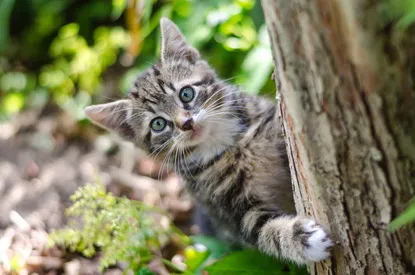Bringing a cat into your home means understanding their natural instincts, especially when it comes to toileting. Many cat owners struggle with indoor litter box issues, but teaching your cat to toilet outside can create a harmonious environment for both you and your pet. Derived from the African wildcat, domestic cats instinctively bury their waste in soft, sandy substrates to avoid predators—a behavior they still exhibit today. By mimicking these conditions in your garden, you can successfully train your cat to use an outdoor toilet. This guide draws from veterinary insights and feline behavior experts to help you achieve just that.
If you’re dealing with a kitten not using litter box, starting with outdoor training early can prevent future problems. Keep reading for practical steps tailored to your cat’s needs.
Modern gardens often feature decking, concrete, or artificial turf, which cats find unappealing for digging. Creating an ideal outdoor setup addresses this, promoting healthier habits and reducing indoor messes.
 ginger cat curled up relaxing on garden decking
ginger cat curled up relaxing on garden decking
Choosing the Right Toilet Type
The foundation of successful outdoor training is selecting the perfect substrate. Cats prefer loose, diggable materials like fine soil, play sand, or even peat-free compost that mimics their ancestral environment. Avoid coarse gravel or compacted earth, as these frustrate their burying instinct.
One effective method is to repurpose a standard litter tray filled with your chosen material and place it outdoors. For a more permanent solution, dig a shallow pit—about the size of a litter tray or larger (roughly 18×24 inches)—and line it with the substrate. Ensure it’s deep enough (6-8 inches) for thorough burial. Maintain this year-round by topping up the material and clearing waste daily to prevent odors and parasites.
In colder climates, freezing can make the toilet unusable. Provide a heated shelter or switch to an indoor alternative temporarily. According to the American Association of Feline Practitioners (AAFP), consistency in substrate type between indoor and outdoor toilets eases the transition, reducing stress-related accidents.
Veterinarians recommend monitoring for signs of discomfort, such as straining or incomplete burial, which could indicate urinary issues. Always consult a vet if you notice blood in urine or frequent attempts.
Selecting the Ideal Location
Privacy is paramount for cats during toileting, as it’s a vulnerable moment. Position the outdoor toilet in a quiet, sheltered spot within your cat’s core territory—ideally near the house or garden edge, not the open center where neighborhood cats or noises might intrude.
Surround it with natural screens like bushes, tall grasses, or a low fence for seclusion. This setup not only shields your cat but also integrates seamlessly into the garden. Elevated platforms with soil trays work well for multi-level gardens.
Proximity to escape routes, like a nearby fence or wall they can climb, adds security. Studies from the University of Lincoln’s cat behavior research highlight that cats choose toileting sites 10-20 feet from shelter, balancing safety and convenience.
 tabby kitten peering around tree
tabby kitten peering around tree
Timing Your Training for Success
Warm, dry weather is optimal for introducing the outdoor toilet, as cats avoid wet or cold conditions. Spring or summer sessions yield faster results, with success rates improving by up to 70% per feline behaviorists at Cats Protection.
Build a simple windbreak using plywood or dense planting to extend usability into cooler months. Gradually entice your cat with familiar scents—rub used litter on the new substrate or place a soiled tray liner inside.
Patience is key; full transition may take 2-4 weeks. Reward usage with treats or praise, reinforcing positive associations without forcing interaction.
For travel-savvy cats, check out tips on how to train your cat to travel to combine outdoor habits with mobility.
Maintaining the Indoor Option
Never remove the indoor litter box during training—cats need choices to avoid anxiety or elimination issues. A gradual shift ensures they adopt the outdoor spot voluntarily. Clean the indoor tray less frequently once outdoor use increases, but keep it accessible.
Multi-cat households benefit from multiple stations to reduce competition. The International Cat Care organization advises one tray per cat plus one extra, split between indoor and outdoor.
Addressing related behaviors, learn how to teach your cat not to scratch furniture for a well-rounded home.
Conclusion
Training your cat to toilet outside requires replicating their natural preferences: soft substrate, privacy, and safety. By focusing on toilet type, location, timing, and retaining indoor access, you’ll foster healthier habits backed by expert veterinary advice. Most cats adapt within weeks, leading to a cleaner home and happier pet.
Consult your veterinarian for personalized guidance, especially for seniors or health-compromised cats. Start today for lasting results—your garden and cat will thank you!
References
- Cats Protection: Cat Toileting Advice
- American Association of Feline Practitioners (AAFP): Litter Box Guidelines
- University of Lincoln Feline Behavior Studies
- International Cat Care: Environmental Needs for Cats
